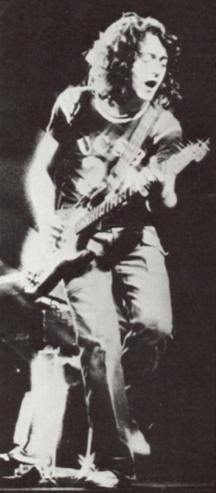Apr 16 2010
Rory Gallagher’s 1980 Australian Tour — Part 3
Another excerpt from the 1980 Australian Tour Program. Part 3: Finishing up of the “story so far”, from 1978 to the 1980 Australian tour. Once again, thanks go to Glenn Shambrook for providing the scans of the Tour Program. You can download a copy of the entire Tour Program (1.8 mb file size) here: 1980 Tour Program.
 Shortly after the final concert of that tour, a raucous event at the London Hammersmith Odeon, Gallagher took time off and made his momentous decision. The time had come, he felt, to make a clean sweep. Drummer Rod DeAth and keyboard player Lou Martin would be departing but bass player, Gerry McAvoy, who has been at Rory’s side since the split with Taste, was to be retained.
Shortly after the final concert of that tour, a raucous event at the London Hammersmith Odeon, Gallagher took time off and made his momentous decision. The time had come, he felt, to make a clean sweep. Drummer Rod DeAth and keyboard player Lou Martin would be departing but bass player, Gerry McAvoy, who has been at Rory’s side since the split with Taste, was to be retained.
The new album, “Photo Finish”, was originally to be released in 1977 and Rory had spent some time in California recording it with American producer, Elliot Mazer. Then came the news that the album would be delayed because Rory had damaged his hand in an accident. It became more apparent, however, that the reason for the delay was that the Irish guitarist was none too happy with the results and being something of a perfectionist, he decided that it should be re-recorded elsewhere.
In the middle of it all came the news that the band was to split and obviously, there would be no recording until Gallagher had settled for a new combination of backing musicians. Here he caused another surprise. Instead of expanding the band — there was even talk of a brass section at one stage — Rory decided to return to his original format, opting for a three-piece, guitar, bass and drums, which was how his band was in the beginning. To complete the trio, he picked up drummer Ted McKenna, formerly the solid backbone of the Sensational Alex Harvey Band. Rory’s career was back in full swing again.
The time came to re-record his new album and Rory searched for a producer. Eventually, he wisely decided on an engineer who could double as a producer and there was not better man available for the job than fellow Irishman, Alan O’Duffy, who had gained invaluable experience working with Paul McCartney and the Rolling Stones. With that, band and producer/engineer, he headed for Germany. At the end of August Rory Gallagher completed recording “Photo-Finish” and this time was satisfied with the outcome.
In addition to recording with a new line up, Rory also was producing with fellow Irishman and engineer Alan O’Duffy (whose previous collaborations have included engineering with Wings and the Rolling Stones) and in a studio new to both, Dieter Dierks’ in Cologne, Germany.
The results showed him moving away from the jazzier inflections he had explored on “Calling Card” towards a more elemental hard rock sound, and constituted an achievement of remarkable poise and power, especially considering how fresh McKenna was to the band.
“Top Priority”, his fourth album for Chrysalis, shows Gallagher and band one year on, welded together by this stage, into as fierce and powerful a three-piece as has been our pleasure to hear: It also finds them completely at home in Dierks’ studio, with Alan O’Duffy at the controls.
 With the combined skills of Rory and O’Duffy coalescing even more surely on production, never before has the guitarist found such a sympathetic setting for his musical genius. The directions suggested by “Photo-Finish” and particularly by tracks like “Shadow Play”, are taken to their logical peak here with a whole new collection of Gallagher classics. In addition to being surefire live killers, songs like “Follow Me” and “Philby” are also perfectly suited to radio play, and are so littered with hooks and immediately identifiable choruses that they’re potentially major hits in their own right.
With the combined skills of Rory and O’Duffy coalescing even more surely on production, never before has the guitarist found such a sympathetic setting for his musical genius. The directions suggested by “Photo-Finish” and particularly by tracks like “Shadow Play”, are taken to their logical peak here with a whole new collection of Gallagher classics. In addition to being surefire live killers, songs like “Follow Me” and “Philby” are also perfectly suited to radio play, and are so littered with hooks and immediately identifiable choruses that they’re potentially major hits in their own right.
Utterly without premeditation Rory captured the mood of the times and made what has the potential to become his biggest seller ever. This is rock music for now — and forever: it is both urgent and enduring.
There is a poetic justice in Gallagher’s realization of his mighty powers in this, his last LP of the 70’s in that blues music from which he has derived much of his inspiration, is more influential and creatively confident than at any time since the turn of the decade.
Rory himself has often been acknowledged as one of the finest blues musicians treading the boards: on guitar and among the finest slide players in the world, he has received the rare accolade of being invited to play with the people that he regarded as his own seminal influences, like blues master Muddy Waters, rocker Jerry Lee Lewis, and British skiffle pioneer Lonnie Donegan.
All his musical passions, form blues and R ‘n’ B to rock and roll and country music are fused in the playing on “Top Priority” — not to mention more esoteric flourishes such as the Gaelic tinged electric sitar on “Philby”. In addition his lyrics and vocals bear the stamp of authority, making this his most substantial album ever, as well as his most exciting.
Rory Gallagher is a man with history, starting with the pioneering days back in Ireland with Taste.
“Top Priority” as the title suggests, is a work of remarkable strength and immediacy. It is at once Rory Gallagher’s distillation of his achievements in the ’70’s and his manifesto for the 80’s. With music like this we’ll be coming back for more, every time.
As Rory explains himself, “When I listen to something, I like to be taken out of my seat and thrown across the room. I like guts, a good drive, which can include gentle stuff too. Whether it’s authentic or not or any other thing, if it sounds good and feels good, that’s it.”
Share on Facebook Rory Gallagher is the man who spearheaded the Irish rock movement. He has often been acknowledged as one of the finest blues musicians treading the boards: a guitar virtuoso and one of the finest slide players in the world.
Rory Gallagher is the man who spearheaded the Irish rock movement. He has often been acknowledged as one of the finest blues musicians treading the boards: a guitar virtuoso and one of the finest slide players in the world.  Taste broke up in 1970, and by early 1971, Rory had formed a new band releasing the album “Rory Gallagher”, somewhat more complex and less raucous than the Taste albums, perhaps due to Rory’s 1969-70 jazz-oriented period.
Taste broke up in 1970, and by early 1971, Rory had formed a new band releasing the album “Rory Gallagher”, somewhat more complex and less raucous than the Taste albums, perhaps due to Rory’s 1969-70 jazz-oriented period.